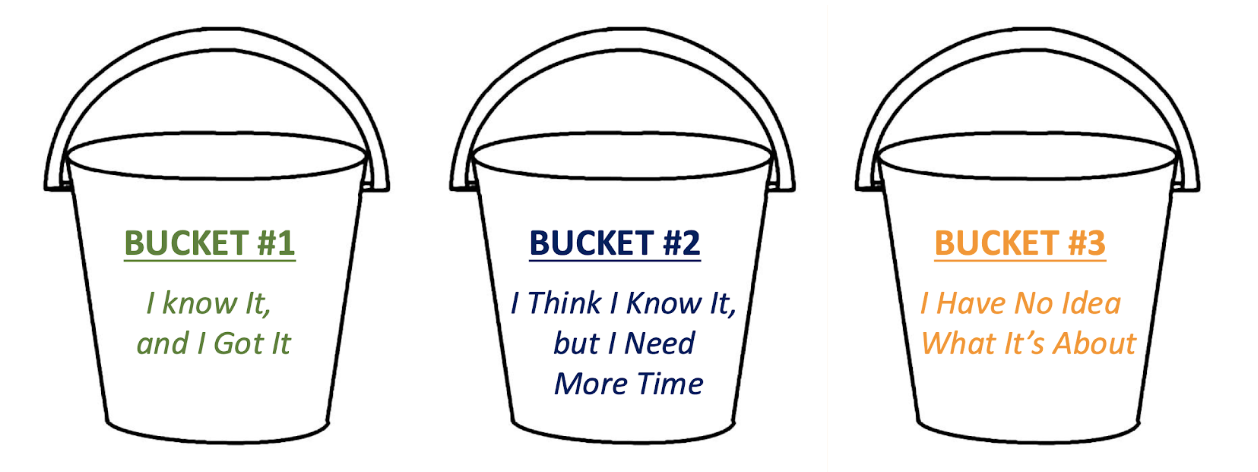Multiple-choice exams are inevitable in our education system. They crop up for students as early as elementary school, follow students all the way through college applications, and persist in university courses and graduate school entrance exams. Having an arsenal of exam strategies ready to deploy during a multiple-choice exam can significantly boost your exam score. One proven strategy to add to your collection is the “bucket method”.
Often, the primary obstacle in obtaining a good exam score isn’t how hard the questions are- it’s time. As a tutor, one point I make early on with students is that if they had unlimited time to take the exam, they could get most of the questions correct and achieve a near perfect score. The challenge is, they do not have unlimited time. Rather, they have a limited, nerve-wracking amount of time to get through dozens of questions in less than dozens of minutes. The “bucket method” is an exam strategy built around the reality that time is a core factor of exam taking.
Earning a high score on an exam isn’t about answering the most questions correctly. It’s about answering the most questions correctly in a given amount of time. This may seem obvious. But, if you meditate on this concept, it can shift how you approach exams and make the “bucket method” an obvious tactic.

The “bucket method” is a question grouping strategy that maximizes the amount of time you spend on questions you can get correct. To use the method, as you navigate the exam group questions into three buckets: (1) the “I know It, and I Got It” bucket, (2) the “I Think I Know It, but I Need More Time” bucket, and (3) the “I Have No Idea What It’s About” bucket. Once you’ve placed the question into one of the three buckets, let the category you’ve grouped the question into modify how you answer it using these guidelines:
Bucket 1: I Know It, and I Got It
Questions that fall into Bucket #1 are questions that you are prepared to answer. You read the question and know exactly what it’s asking you. When you look over the answer options, the answer you arrived at is clearly there. You’re confident in your answer. You should complete the Bucket #1 questions quickly as you can while maintaining accuracy. Then, once you answer these questions, do not return to them. You spent the time needed to get points for Bucket #1 questions. The remainder of your time is better spent on questions in the other two buckets.
Bucket 2: I Think I Know It, but I Need More Time
When you read questions in Bucket #2, you know the concept that it’s asking about but you’re not totally sure how to approach it. Maybe you can remember seeing similar questions in your exam prep. You may know how to start to solve the question. Maybe you arrive at an answer, but you’re not completely confident in it. Or perhaps the solution you arrived at isn’t an answer choice. For now, answer the question with your best guess or the answer you’re most confident with and move on. Bucket #2 questions are the ones to come back to with any extra exam time.
Bucket 3: I Have No Idea What It’s About
The questions that fall into Bucket #3 are questions that you read two or three times and have no idea where to start. You try to look for key terms or clues indicating how the question relates to the material you studied. Then, you try to work backwards from the answers to no avail. Once you place a question in Bucket #3, you should move on from it as quickly as possible. If your exam does not deduct for incorrect answers, guess an answer at random and stop spending time on the question. This time is better spent on the questions in Bucket #2. If and only if you have time remaining after returning to all questions in Bucket #2, you can retry the questions in Bucket #3.
All exam questions can be groups into Buckets #1, #2, or #3. When you first try the bucket method, it takes conscious effort to remember to place each question into a bucket. However, with training, it becomes an unconscious tactic that you can use on all multiple-choice exams.
In practice, the “bucket method” can look different from user to user. For paper exams, one way to deploy the bucket method is to put a slash through question numbers that are in Bucket #1, circle question numbers that are in Bucket #2, and leave question numbers that are in Bucket #3 blank. This visually distinguishes which questions are in which bucket when you go back through the exam. And this takes milliseconds to do. Or you can simply write “1”, “2”, or “3” next to each question. For computer exams, you can create buckets on your scratch paper and place question numbers into each bucket as you go along. For efficiency, you only need to make two of the three buckets, like Bucket #2 and Bucket #3, so that you know which questions to go over again and which questions to skip altogether.
In summary
Of course, practicing the “bucket method” is only one component of exam preparation. While it ensures that you spend your exam time on questions that you can get correct, preparing for the exam by studying and with practice exams is still essential. Thinking within the “bucket method” framework, a goal of exam prep is to ensure that when you sit down to take the exam most of the questions are in Bucket #1. And, as you spend time preparing and practicing, more questions will move from Bucket #3 to Bucket #2 and from Bucket #2 to Bucket #1.
In all, the “bucket method” is a strategy that optimizes you spending your exam time on questions that you can answer correctly and, thus, optimizes your exam score.

Comments